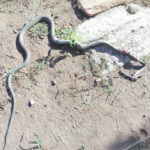Over a period of just days, a total of 34 individuals resurfaced from the perilous depths, offering chilling accounts of their subterranean existence. Their stories paint a picture of forced labour, brutal conditions, and a complex criminal network operating with impunity.
On Thursday, 28 November, 17 zama zamas emerged from two separate mine shafts. Among them were teenagers who hadn’t seen daylight since May 2024. One 19-year-old described a surprisingly well-equipped underground world: “We used to go to work as early as six in the morning and then come back around 4pm, take a bath and then sleep. Or go to the shops and watch TV. We have TVs, fridges and speaker boxes.”
He detailed their routine, highlighting the stark contrast between their harsh working conditions and the surprisingly comfortable living quarters. He also revealed that supplies, including food, are delivered every three months by individuals descending into the mines.
The harsh realities of life underground were further emphasized by another teenager’s account. He described the struggle for survival, relying on salt water to quench their thirst: “Others had food. We didn’t have food. We would warm water and drink it, staying in prayer and believing that we would one day be able to escape. We have a plan, and we plan to tell the cops the truth about what is happening underground.”
Adding to the growing concern, a further six miners emerged on Friday, 29 November, prompting a second visit to Stilfontein by Police Minister Senzo Mchunu. During a media briefing, Minister Mchunu stressed the need for stability and order: “We don’t want anybody to threaten anybody. We want stability, order, peace and security in the country. To have all these things, there must be responsible people who must ensure that within the law, those things happen.” He also highlighted the issue of undocumented foreign nationals involved in illegal mining activities.
Then, late on Sunday night, 14 more zama zamas surfaced from a disused mine, where a major operation against illegal mining is underway. These Mozambican miners, arrested by police guarding the shaft entrance, were found in a desperate state. Their clothes were torn and muddy, some were barefoot, and they bore cuts on their hands. They had spent several days climbing up giant steel girders, navigating the perilous depths of a shaft deeper than 1.5km, which lacked ventilation and emitted hot, billowing steam.
Newsroom Afrika reporters interviewed some of the men before their arrest. Their accounts revealed a pattern of deception and coercion. One man described being offered a job in Johannesburg while waiting for work in Middelburg. He said goodbye to his wife and four children, unaware that this job would lead him to one of the world’s most dangerous mines. The minibus carrying him and others bypassed Johannesburg, heading to Stilfontein, where they were forced underground at gunpoint. Similar recruitment tactics were used in Diepsloot and Alexandra, with Basotho men identified as the recruiters.
Stilfontein, situated near Klerksdorp, has become a focal point for South Africa’s illicit gold industry. Abandoned mine shafts, remnants of a bygone era of industrial mining, now serve as havens for powerful gangs. A mine security expert from Orkney estimated that 500 men could work in a single shaft, mining 30 grams of gold weekly – a staggering potential profit of over R60 million monthly per shaft, given the black market price of gold. Analysts estimate illegal mining accounts for around 10% of South Africa’s annual gold production, potentially representing over R15 billion worth of gold.
The persistence of this illicit economy is attributed to various factors: numerous disused shafts, weak enforcement of mine closure regulations, high poverty and unemployment rates in former mining towns, and widespread corruption. Syndicates not only extract gold from abandoned shafts but also infiltrate operational mines through bribery. The operation is structured like a pyramid scheme, with white-collar criminals at the top laundering gold, and the miners at the bottom, trapped in a cycle of debt and danger.
For decades, heavily armed Lesotho gangs have controlled access to the shafts, demanding exorbitant fees. One zama zama described paying R10 000 to enter and R25 000 to exit a mine, often financed by gold buyers in exchange for a share of the gold produced. The high cost of food and supplies underground further exacerbates the miners’ debt. Some miners remain underground for months or years, emerging with nothing.
One zama zama, who worked as a “cage operator” transporting men and supplies, described witnessing young men, mostly from Mozambique and Zimbabwe, forcibly taken underground, often in tears. He recounted a horrific incident where a teenager’s testicles were torn during a descent, highlighting the brutality of the conditions.
A recent joint police and military operation attempted to starve the zama zamas out by cutting off their supplies. Over 1300 miners have been arrested, many from Mozambique and Zimbabwe, including about 100 undocumented children. The escape of the 14 men on Sunday has been interpreted by police as evidence that the zama zamas are not trapped, but rather avoiding arrest. However, a community leader in Stilfontein countered this, stating that the miners are “caught between the police and the gangs,” facing a “double victimisation.” Hundreds of men are still believed to be trapped underground, highlighting the continuing urgency of the situation.

Follow @MyZimbabweNews












